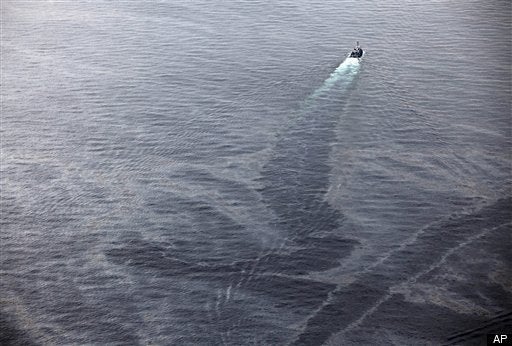
Last week's much-ballyhooed new federal estimate of how much oil is spewing into the Gulf of Mexico -- 12,000 to 19,000 barrels a day, or two to four times as much as the original estimate -- remains a low-ball figure.
The numbers released by the government last week and quickly adopted by the mass media actually represent the lower range of "lower bounds" generated by using conservative assumptions and flawed measures, according to documents released on Thursday.
The newly-released summary of the report from the Department of Interior's "Flow Rate Technical Group" doesn't disclose the higher bounds, however, declaring that a reliable upper figure was incalculable due to -- get this -- "known unknowns" and "unknown unknowns."
(It was Bush-era Defense Secretary Donald Rumsfeld who first coined those terms in February 2002 when asked for evidence of a direct link between alleged Iraq weapons of mass destruction and terrorist organizations.)
For more than a month after the well blew out, BP and the National Oceanographic and Atmospheric Administration (NOAA) had been estimating the flow at 5,000 barrels, or about 210,000 gallons, a day. NOAA based its number on the amount of oil visible on the surface of the Gulf -- and stuck to that, even after marine scientists pointed out that due to the depth of the leak and the use of dispersants, a high proportion of the oil was staying beneath the surface.
Media reports continued to use that figure even after a video clip of the spewing pipe exposed it as a farce. Finally on May 27, the Interior Department issued a press release, describing 12,000 to 19,000 barrels as a "preliminary best estimate" of the flow.
Two members of the team did tell PBS the next day that the 12,000 to 19,000 figure was just the range of the "lower bound." Yet the figure was widely accepted as the entire range of possibilities.
One of the methods the team used to arrive at its numbers was based on an estimate of the oil detected on the ocean surface. The new report states that: "The team then corrected the value for oil evaporated, skimmed, burned, and dispersed up to that day and divided by time to produce an average rate."
But there is nothing remotely like agreement in the scientific community about how much of the oil remains beneath the surface. Some scientists think the vast majority remains suspended in the water column. By contrast, NOAA's director has a hard time acknowledging there is any at all.
How the flow-rate team "corrected" for something they didn't know about remains a secret. Overall, however, even including the amount of oil evaporated, skimmed or burned, the team's lower bound for the flow amounted to less than double the amount visible on the surface.
And the new document acknowledges that further scientific investigation could push its estimates higher, due to "unknown processes that remove oil naturally from the system" as well as "unknown unknowns."
Another estimation method involved calculating the size of the plume based on video from the sea floor. It had a whole different set of challenges, including a limited window of data (seven minutes!), poor quality footage, an untested methodology and a series of assumptions that may or may not have been correct.
The scientists pursuing that method also found their guesswork limited by "the effect of the unknown unknowns" which "made it more difficult to produce a reliable upper bound on the flow rate."
So the actual flow could be much, much greater than any of the numbers the government will discuss -- but we don't even know by what factor.
One congressional investigator, irate over the assertion that the group corrected for "unknown unknowns," shot back in an email to the Department of the Interior: "I've never heard of this before in math. Help me understand your thinking."
Even at 12,000 to 19,000 barrels -- or about 500,000 to 800,000 gallons -- a day, the BP disaster, now in its 45th day, long ago eclipsed the 250,000 barrels spilled by the Exxon Valdes.
There's a very good reason one party to all this would want to low-ball flow estimates. As Mother Jones environmental reporter Kate Sheppard recently noted: "The base fine for a spill is $1,100 a barrel, but it can go as high as $4,300 a barrel if a federal court determines that the spill was the result of gross negligence by the responsible party."
Should it come to that, at 12,000 barrels a day for 45 days -- at the base fine amount -- that would amount to $594 million; at 19,000 barrels, that would amount to about $940 million; at, say, 50,000 barrels, that would amount to about $2.5 billion. (And all those numbers would quadruple in case of gross negligence.)
Even for BP, that's real money. The company earned $4.4 billion in profits in 2009.
Marcia McNutt, the director of the U.S. Geological Survey and author of the group's report, last week defended the lack of an upper bound. She blamed variations in the gas and oil outflow.
She did hold out the hope that additional video supplied by BP could result in a higher bound estimate at some point in the future, but none has been forthcoming so far.
Meanwhile, a computer modeling study released Thursday suggests that some of that oil might soon extend along thousands of miles of the Atlantic coast.
The National Center for Atmospheric Research, a National Science Foundation program in Colorado, has animated computer simulations showing how, once oil gets caught in the Gulf of Mexico's fast-moving Loop Current, it is likely to reach Florida's Atlantic coast within weeks. It could then move north as far as Cape Hatteras, North Carolina, with the Gulf Stream, before turning east.
WATCH THE PROJECTION:
*************************
Dan Froomkin is senior Washington correspondent for the Huffington Post. You can send him an e-mail, bookmark his page; subscribe to RSS feed, follow him on Twitter, friend him on Facebook, and/or become a fan and get e-mail alerts when he writes.
